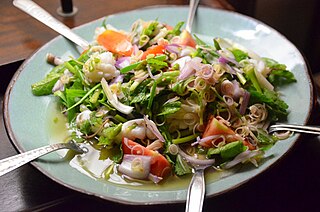
Cantonese or Guangdong cuisine, also known as Yue cuisine is the cuisine of Guangdong province of China, particularly the provincial capital Guangzhou, and the surrounding regions in the Pearl River Delta including Hong Kong and Macau. Strictly speaking, Cantonese cuisine is the cuisine of Guangzhou or of Cantonese speakers, but it often includes the cooking styles of all the speakers of Yue Chinese languages in Guangdong.

Steaming is a method of cooking using steam. This is often done with a food steamer, a kitchen appliance made specifically to cook food with steam, but food can also be steamed in a wok. In the American southwest, steam pits used for cooking have been found dating back about 5,000 years. Steaming is considered a healthy cooking technique that can be used for many kinds of foods.

Malaysian cuisine consists of cooking traditions and practices found in Malaysia, and reflects the multi-ethnic makeup of its population. The vast majority of Malaysia's population can roughly be divided among three major ethnic groups: Malays, Chinese and Indians. The remainder consists of the indigenous peoples of Sabah and Sarawak in East Malaysia, the Orang Asli of Peninsular Malaysia, the Peranakan and Eurasian creole communities, as well as a significant number of foreign workers and expatriates.

Malay cuisine is the traditional food of the ethnic Malays of Southeast Asia, residing in modern-day Malaysia, Indonesia, Singapore, Brunei, Southern Thailand and the Philippines as well as Cocos Islands, Christmas Island, Sri Lanka and South Africa.

Singaporean cuisine is derived from several ethnic groups in Singapore and has developed through centuries of political, economic, and social changes in the cosmopolitan city-state.

Filipino cuisine is composed of the cuisines of more than a hundred distinct ethnolinguistic groups found throughout the Philippine archipelago. A majority of mainstream Filipino dishes that compose Filipino cuisine are from the food traditions of various ethnolinguistic groups and tribes of the archipelago, including the Ilocano, Pangasinan, Kapampangan, Tagalog, Bicolano, Visayan, Chavacano and Maranao ethnolinguistic groups. The dishes associated with these groups evolved over the centuries from a largely indigenous base shared with maritime Southeast Asia with varied influences from Chinese, Spanish and American cuisines, in line with the major waves of influence that had enriched the cultures of the archipelago and adapted using indigenous ingredients to meet local preferences.
The city of Ipoh is the administrative capital of the Malaysian state of Perak and is famous for its cuisine. Its food culture is driven by its majority Chinese population who are largely of Cantonese and Hakka descent. There is also Malay and Indian food in Ipoh; the nasi kandar served by a prominent local Mamak stall is nicknamed nasi ganja due to its supposed addictive properties. Specialty foods from neighbouring towns are also available in Ipoh.

The following outline is provided as an overview of and topical guide to food preparation:

Peranakan cuisine or Nyonya cuisine comes from the Peranakans, descendants of early Chinese migrants who settled in Penang, Malacca, Singapore and Indonesia, inter-marrying with local Malays. In Baba Malay, a female Peranakan is known as a nonya, and a male Peranakan is known as a baba. The cuisine combines Chinese, Malay, Javanese, South Indian, and other influences.

Soups in East Asian culture are eaten as one of the main dishes in a meal or in some cases served straight with little adornment, particular attention is paid to the soups' stocks. In the case of some soups, the stock ingredients become part of the soup. They are usually based solely on broths and lacking in dairy products such as milk or cream. If thickened, the thickening usually consists of refined starches from corn or sweet potatoes.

Ching bo leung is a sweet, cold soup of Chinese origin and commonly served in Cantonese cuisine, Hainanese cuisine and Guangxi cuisine. It is a popular dessert in Malaysia and Singapore. It is a type of tong sui. In Singapore it is known as 清汤. It is known as sâm bổ lượng or chè sâm bổ lượng in Vietnam.

Fruit soup is a soup prepared using fruit as a primary ingredient, and may be served warm or cold depending on the recipe. Some fruit soups use several varieties of fruit, and alcoholic beverages such as rum, sherry and kirsch may be used. Fruit soup is sometimes served as a dessert.

Chinese cooking techniques are a set of methods and techniques traditionally used in Chinese cuisine. The cooking techniques can either be grouped into ones that use a single cooking method or a combination of wet and dry cooking methods.

Salads that are internationally known as Thai salads with a few exceptions fall into four main preparation methods. In Thai cuisine these are called yam, tam, lap and phla. A few other dishes can also be regarded as being a salad.

Hot pot or hotpot, also known as soup-food or steamboat, is a dish whereby a heat source placed on the dining table keeps a pot of soup stock simmering, and a variety of Chinese foodstuffs and ingredients are served beside the pot for the diners to put into the hot stock.
Ginseng chicken soup is a type of soup, which involves chicken and ginseng as one of the main ingredients. Ginseng can typically be cooked with chicken in broth, porridge, and soups. Varieties of ginseng chicken soup can be found in Asian countries, such as China, Malaysia, and Korea.
















